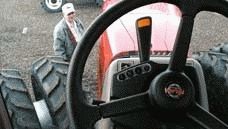TRACTORS, TRANNIES AND TECH OH, MY!
Published 12:00 am Monday, March 1, 2004

- Comfort reigns supreme with Case's spacious new Surveyor Cab. With plenty of legroom and panoramic visibility, the cab's electrohydraulic, ergonomic Optima seating puts the driver on top of the world. (The Observer/MARDI FORD).
It’s not your
Trending
grandpa’s tractor any more.
Gone are the days of rough-riding, open to the elements and one-size-fits-all chemical application.
The workhorse standard of the farm scene today’s tractor may be as luxurious and definitely more expensive than most cars or trucks.
Trending
With electrohydraulic, ergonomic seating and improved sound abatement, climate control and improved visibility from within the cab, today’s farmer is assured a comfortable ride a definite consideration for a job that requires sitting in the same place for hours on end.
More important, with less distraction, the farmer can better concentrate, hear and see what is going on beneath and around him in the field.
Farmers are particular about their tractors, says Russ Cook of La Grande New Holland/Case IH.
"Once they find a line they like," Cook says, "they stick to ’em."
Cook sells both New Holland tractors, the blue ones, and Case IH, the red ones, and says that over 70 percent of his line has been upgraded in ergonomics, electronics, hydraulics and suspension in the past few years.
While his fastest growing market is for compact tractors, especially New Holland’s Boomer series, Cook says mid-size tractors are still the most popular, especially for cattle ranchers, hay farmers, as well as row crop.
New Holland’s popular mid-size, the brilliant blue TS125A, has four axle choices, including New Holland’s exclusive SuperSteer four-wheel drive for manuevering in tight corners, or their TerraGlide, a suspended four-wheel drive axle for improved traction over rough terrain.
But, the big tractors 140 to 240 horsepower are still in the dreaming stage for most, Cook says, although he sees the market for farm equipment is the "most optimistic since 9/11."
Cook’s current big boy on the lot is Case IH’s scarlet MX230 with front and rear "duallies," a spacious cab,complete with a "buddy" seat in the bells and whistles command center, and the smooth ride of a luxury sedan.
The MX Series Magnum tractor’s transmission allows shifting through 18 forward and four reverse gears without clutching or jolting.
But even with luxury cabs, bright colors and sexy lines reminiscent of a beefed-up dune buggy, today’s tractors are more than mere show ponies.
Just as 21st century farmers have continually risen to higher standards of production, quality and record-keeping, so has the technology available for farm equipment.
At S&G Machinery Co. in Island City, John Stebbins and Moe Donigian are proud of the commitment John Deere has made to develop new and better technology for its line of farm machinery and equipment.
The newest innovations at John Deere, according to Stebbins and Donigian, are in the Ag Management Solutions, a farm management tool comprised of both software and hardware.
What AMS does is tap into satellite technology’s global positioning systems, analyzing a field, a crop or the soil in both broader grid areas, or down to the inch, if you prefer. AMS will then calculate the correct amount of water or chemicals to apply, or seed to plant. It will even monitor and map yield.
All of the analysis and application data is stored in the system for record keeping and documentation. It’s an important feature, Stebbins says, because federal and state regulations have increasingly required farmers to keep more detailed records of chemical applications and keep them on hand for years.
To enhance AMS, John Deere also offers hardware that goes beyond what is readily available through satellite GPS technology by enhancing tracking in real- time kinetics that will pick up and stabilize satellite positioning within a 6-mile radius. That eliminates drift and allows for "near 100 percent accuracy" in precision farming, said Donigian.
Though the enhancement in AMS with the real-time kinetics technology starts at $6,500, Donigian says the system will pay for itself by reducing waste and increasing efficiency.
"It’s encouraging," Stebbins says, "and we’d like people to take a look at what AMS will real-time kinetics will do for them."
John Deere has also made improvements to its transmission with the development of infinite variable transmissions, Stebbins says, which increases fuel economy and engine efficiency.
Basically, there are two computers one in the engine and one in the transmission that talk to each other continually and adjust power and fuel for maximum performance. So, Donigian says, you get exactly what you need, exactly when you need it.
If only everything else was that simple in the complicated business of farming in the 21st century.
It’s definitely not your grandpa’s farming anymore.
Story and photo by Mardi Ford









